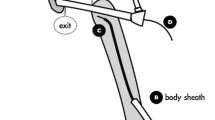Abstract
The Venous Window Needle Guide (VWING™) has recently been proposed for patients with difficult arteriovenous fistula (AVF) access for hemodialysis due to deep vessels or other cannulation-related problems. This totally subcutaneous titanium device is sutured onto the upper wall of the matured fistula and may facilitate cannulation by the button-hole technique. We describe our initial experience with nine implants in six patients with a cumulative follow-up of 83 months, and make some experience-based technical suggestions for implant and surveillance radiological imaging. The indication for implantation was deep vessel, previous failure of cannulation or unsuitable site for direct cannulation. No infectious complications were observed during follow-up and proper blood flow was constantly achieved. Some difficulties were occasionally encountered with regard to cannulation; nonetheless, patient satisfaction was not significantly affected. VWING seems to be an interesting option in some patients provided that surgical implantation is carefully carried out and preventive measures against infections are strictly observed.






Similar content being viewed by others
References
Renal Association Guidelines: Vascular Access for Hemodialysis (2015) http://www.renal.org/guidelines/modules/vascular-access-for-haemodialysis#sthash.BBYFFliX.3wAczg1H.dpbs. Accessed 31 May 2015
Clinical Practice Guidelines for Vascular Access (2006) AJKD 48(Suppl 1):S178–S179
Tordoir J, Canaud B, Haage P et al (2007) EBPG on vascular access. Nephrol Dial Transplant 22(Suppl 2):ii88–ii117
Caballero B (2007) The global epidemic of obesity. An overview. Epidemiol Rev 29:1–5
Allon M, Ornt DB, Schwab SJ, Rasmussen C, Delmez JA, Greeen T, Kusek JW, Martin A, Minda S, for the Hemodialysis (HEMO) Study Group (2000) Factors associated with the prevalence of arteriovenous fistulas in hemodialysis patients in the HEMO study. Kidney Int 58:2178–2185
Pisoni R, Young E, Dykstra D, Greenwood R, Heckling E, Gillespie B, Wolfe R, Goodking DA, Held PJ (2002) Vascular access use in Europe and the United States: results from the DOPPS. Kidney Int 61:305–316
Bourquelot P, Tawakol JB, Gaudric J, Natário A, Franco G, Turmel-Rodrigues L, Van Laere O, Raynaud A (2009) Lipectomy as a new approach to secondary procedure superficialization of direct autogenous forearm radial-cephalic arteriovenous accesses for hemodialysis. J Vasc Surg 50:369–374
Ochoa DA, Mitchell RE, Jennings WC (2010) Liposuction over a shielded arteriovenous fistula for hemodialysis access maturation. J Vasc Access Jan-Mar 11(1):69–71
Bourquelot P, Lamisse RE, Pirozzi N (2015) Transposition, elevation, lipectomy and V-Wing for easy needling. J Vasc Access 16(Suppl. 9):108–113
Hill A, Vasudevan T, Young NP, Crawford M, Blatter DD, Marsh E et al (2013) Use of an implantable needle guide to access difficult or impossible to cannulate arteriovenous fistulae using the buttonhole technique. J Vasc Access 14:164–169
Jennings WC, Galt SW, Shenoy S, Wang S, Ladenheim ED, Glickman MH, Kathuria P, Browne BJ (2014) The Venous Window Needle Guide, a hemodialysis cannulation device for salvage of uncannulatable arteriovenous fistula. J Vasc Surg 60:1024–1032
Lee T, Barker J, Allon M (2006) Needle infiltration of arteriovenous fistulae: risk factors and consequences. AJKD 47(6):1020–1026
Tordoir JHM, van Loon MM, Peppelenbosch N, Bode AS, Poeze M, van der Sande FM (2012) Surgical techniques to improve cannulation of hemodialysis vascular access. Eur J Vasc Endovasc Surg 39:333–339
Twardowski Z (1979) Different sites versus constant sites of needle insertion into arteriovenous fistulas for treatment of repeated dialysis. Dial Transplant 8:978–980
Atkar RK, MacRae JM (2013) The buttonhole technique for fistula cannulation: pros and cons. Curr Opin Nephrol Hypertens 22(6):629–636
Nesrallah GE, Cuerden M, Wong J, Pierratos A (2010) Staphylococcus aureus bacteremia and buttonhole cannulation: long-term safety and efficacy of mupirocin prophylaxis. Clin J Am Soc Nephrol 5:1047–1053
O’Brien FJ, Kok HJ et al (2012) Arterio-venous fistula buttonhole cannulation technique: a retrospective analysis of infectious complications. Clin Kidney J 5:526–529
Grudzinski A, Mendelssohn D, Pierratos A, Nesrallah G (2013) A systematic review of buttonhole cannulation practices and outcomes. Semin Dial Jul-Aug 26(4):465–475
Bronder C, Cull D, Kuper S, Carsten C, Kalbaugh C, Cass A, Taylor S (2008) Fistula elevation procedure: experience with 295 consecutive cases during a 7-years period. J Am Coll Surg 206(5):1076–1081
Author information
Authors and Affiliations
Corresponding author
Ethics declarations
Conflict of interest
On behalf of all authors, the corresponding author states that there is no conflict of interest.
Ethical statement
All patients provided informed consent in accordance with the principles of the Declaration of Helsinki. The authors declare no conflict of interest and declare: no support from any organisation for the submitted work; no financial relationships with any organisations that might have an interest in the submitted work in the previous 3 years; no other relationships or activities that could appear to have influenced the submitted work.
Rights and permissions
About this article
Cite this article
Forneris, G., Trogolo, M., Cecere, P. et al. Venous Window Needle Guide for deep vessels and difficult arteriovenous fistula cannulation. J Nephrol 30, 435–440 (2017). https://doi.org/10.1007/s40620-016-0328-z
Received:
Accepted:
Published:
Issue Date:
DOI: https://doi.org/10.1007/s40620-016-0328-z




